IDEX Online Research: Jewelry Retail Closings in U.S. Have Slowed
October 08, 09
How many specialty retail jewelers are going to close this year in the U.S.? IDEX Online Research frequently receives that question. The answer: not as many as you might think!
At the current pace, it appears that the U.S. market will lose just over 700 specialty jewelry businesses in 2009, based on new data from the Jewelers Board of Trade, the jewelry industry’s credit bureau and keeper of the business census. That’s roughly 20 percent more than in 2007 and 2008, but it’s about in line with the average annual loss – 688 specialty jewelry businesses – for the past decade. Earlier this year (in July), we had predicted that the U.S. jewelry market might lose as many as 1,000 jewelry retailers in 2009. However, the pace of closings has slowed, especially during the summer, which is historically a peak period for jewelry store closings.
There is an offset to business closings: we are expecting roughly 185 new specialty jewelry businesses to open this year.
After netting openings – 185 or so – against closings – just over 700 – the U.S. jewelry industry will have a net loss of near 500 businesses for the year, or just over 2 percent of industry capacity. In terms of jewelry doors closings, we are forecasting that a net of about 3 percent of total jewelry industry doors will close in 2009, based on statistics for the year-to-date through August.
Why aren’t jewelry store closings higher? There are two key reasons:
- Retail store closings – including jewelry stores – tend to lag economic cycles. In many ways, retail store closings are similar to unemployment – the unemployment rate tends to climb for as much as a year after an economic recovery begins. That’s just the way things work.
- Retailers don’t die easily or quickly. Merchants often stay in business long past they time they should close. By running down inventory and hoarding cash, retailers can stay in business for quite a long time because the business is not particularly capital intensive.
Jewelry Store Closings Slower This Summer
Here are the highlights of our analysis of year-to-date data from the Jewelers Board of Trade (JBT) report through the month of August:
- Specialty jewelry business closings through August – 474 – are up about 10 percent from last year’s levels through August. However, this level of closings is about in line with the average number of business closings – 485 specialty jewelry businesses – through August of each year over the past decade.
- On a net basis, the total number of retail jewelry businesses in operation in the U.S. is down less than 2 percent through August. On January 1, 2009, there were 22,623 jewelry retail businesses, according to JBT; at the end of August, there were 22,271 jewelry retailers. By the end of the year, IDEX Online Research believes that there will be about 22,000 specialty jewelry businesses in operation in the U.S. market. These numbers net closings against openings. Ten years ago – in August 1999 – there were 26,891 specialty jewelry retail businesses in the U.S., according to the JBT census.
- Jewelry wholesalers’ closings this year through August – about 150 businesses – are more than five times the number of closings for the same eight-month period last year – 28 businesses. We note, however, that wholesaler closings through August in 2008 were unusually low. Typically, an average of 55 wholesalers have closed each year through August over the past decade. Thus, the closing rate for jewelry wholesalers year-to-date in 2009 is running at three-times the normal rate for the same eight-month year-to-date period over the past decade.
- Jewelry manufacturing businesses are closing at a rate about 34 percent greater this year – 95 businesses – versus last year’s closings of 71 businesses through August.
- Jewelry business bankruptcies – retailers, wholesalers and manufacturers – through August are double last year’s levels through the same eight-month period.
Retail Closings Up, But Not By a Large Number
For the year-to-date, about 474 retail jewelry businesses in the U.S. have closed. It is important to understand “jewelry businesses,” as defined by the Jewelers Board of Trade. First, a jewelry business is a single company; it may have multiple stores. For example, Zale is counted as “1” jewelry business. Thus, this is not a census of stores or store closings; rather, it is a census of business closings. Second, the JBT numbers, with one exception, include only “listed” jewelers, those that JBT rates in its database. Other jewelers are “non-listed,” most likely because they don’t do a meaningful level of business. “Specialty jewelers” are those who do a majority of their business in jewelry, and are classified NAICS 44831.
Further, it is important to note that the Jewelers Board of Trade census does not include every jewelry business in the U.S. However, it includes more than 90 percent of all jewelry businesses, and it includes close to 100 percent of those jewelry businesses that have a meaningful presence in the industry.
In a typical year over the past decade, about 485 retail jewelers have closed their doors through the end of August. So far in 2009, 474 specialty jewelers have closed. In 2008, 430 jewelers had closed their doors by the end of August. Thus, the level of retail jewelry business closings in 2009 – a recession period – has not been dramatically higher than in prior boom or bust periods, as many people had expected.
The graph below illustrates the number of retail jewelers who closed their businesses though August of each of the years shown:
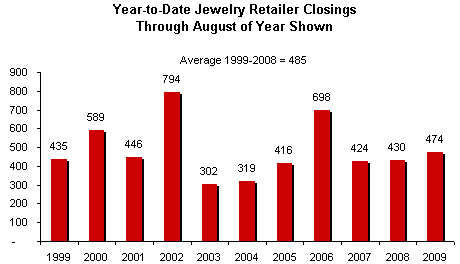
Source: BLS
Unfortunately, it is not possible to determine the number of jewelry stores or doors which closed in either 2008 or 2009. Government business census data at the store/door level lags by about two years. However, we know that both Friedman’s and Whitehall closed a large number of stores over the past couple of years; that removed significant capacity from the industry. Business closings so far in 2009 reflect far fewer chains shuttering their doors, so industry capacity has not declined dramatically – perhaps by 2-3 percent from last year through August.
Wholesalers Dropping Like Flies
It should come as no surprise that the number of jewelry wholesalers who have closed this year is rising dramatically. Through the end of August, 150 jewelry wholesale businesses have closed; last year, only 28 had closed for the year-to-date through August. Further, in a typical year, roughly 55 wholesalers closed their doors for the first eight months of the year. Clearly, the recessionary environment is taking its toll on jewelry wholesalers. Further, banks seem particularly unwilling to lend to wholesalers. In addition, wholesalers’ memo goods are often not safe when a retailer takes bankruptcy. Finally, it is difficult to determine how wholesalers add value; thus, many retailers are skipping wholesalers and dealing directly with manufacturers.
The graph below illustrates the number of jewelry wholesale businesses which have failed so far this year, though the end of August.
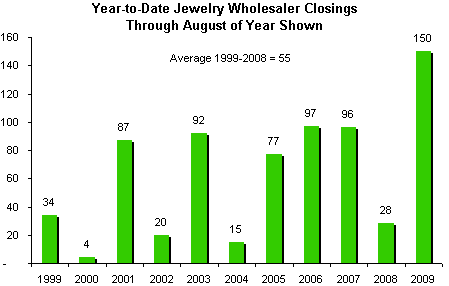
Source: BLS
Jewelry Manufacturers’ Closings Rise, But Not Greatly
Through the end of August, 95 jewelry manufacturing businesses had closed in the U.S. This was only marginally above the average of 88 closings for the first eight months of the year over the past decade. Thus, manufacturing closings are running about 8 percent above the average for the year-to-date period. Many manufacturers have already abandoned the U.S. market, and are now producing goods in low-cost markets across Southeast Asia.
Compared to last year, jewelry manufacturing closings are up about 34 percent; however, 2008 was a year in which a below-average number of jewelry producers closed.
The graph below summarizes jewelry manufacturers’ closing for the year-to-date period through August for each of the years shown.
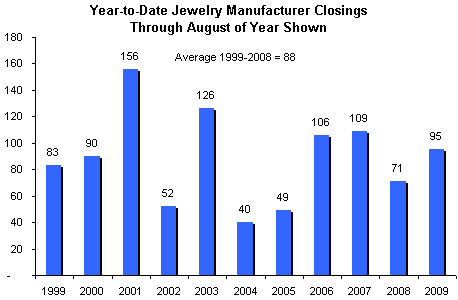
Source: BLS
Why Jewelers Fail
In an effort to determine why jewelers go out of business, the Jewelers Board of Trade began keeping detailed statistics in 2008. It is important to understand that these numbers do not correlate exactly with the total failures shown above (retailers + wholesalers + manufacturers) since the database for the “failure analysis” is larger because it includes non-listed businesses as well as information from a variety of other sources.
Here’s what this data shows:
- The number of businesses which have “ceased doing business” reached 1,083 at the end of August, up nearly 50 percent from last year’s levels for the first eight months, as the red bars on the graph below illustrates. This is a direct result of the recessionary environment. Businesses classified as “ceased doing business” generally have folded their tent and stolen off into the dark of the night. They do not include those merchants who filed for bankruptcy (see below).
- The number of businesses which were sold or merged was down modestly, as the green bars on the graph below illustrate. Again, this is no surprise, since the market for business sales has nearly dried up. Besides the lack of credit availability for business buyers, business valuations are down dramatically. Unfortunately, too many sellers still think their businesses are worth today what they were worth two or three years ago. In today’s market, businesses are worth only a fraction of their value in 2006 or perhaps 2007.
- The number of jewelry businesses which declared bankruptcy doubled in the first eight months of 2009 versus the same period a year ago, as shown by the blue bars on the graph below. Bankruptcies are not included in the category “ceased doing business” above.
The graph below compares year-to-date data for the three primary reasons that jewelry businesses fade from the scene.
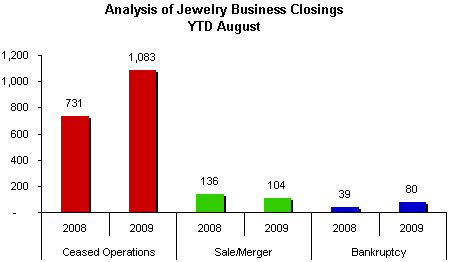
Source: BLS
Forecast: Not As Dire As Expected for Retailers
First, a disclaimer: IDEX Online Research is not yet forecasting business closings for either wholesalers or manufacturers. There are two many unknown factors at this point.
However, we are comfortable forecasting jewelry retailers’ closings, since an analysis of the data for the past two decades yields surprisingly consistent results, despite economic cycles and other external events.
Background
Jewelry store closings tend to peak in January and July. Why? In January, retailers are flush with cash, and they can pay their vendors and go out of business with their head held high. In July, most merchants have completed their meetings with bankers, and many have gotten bad news: very limited credit availability for the upcoming holiday selling season. So, they simply shut down.
The graph below illustrates the percentage of jewelers closing by month during the year. The total of the percentages equals 100 percent. IDEX Online Research used data – more than a decade’s worth of numbers – from this graph, coupled with other data, to create the forecast for jewelry store closings.
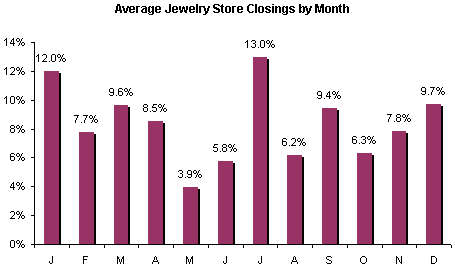
Source: BLS
Fearless Forecast
Here’s our fearless forecast for 2009 for jewelry retailer closings, based on year-to-date data. Our assumptions are that the economy doesn’t recover quickly, that closings roughly follow historical patterns and that there is no system shock.
- Just over 700 jewelry retail businesses are expected to close this year, a 19 percent increase over the number of retail jewelry businesses which closed last year.
- On a net basis, the U.S. jewelry industry will probably decline by roughly 525 jewelry retailers this year, or 2.3 percent of capacity. In terms of doors closings, the loss could be about 3 percent or so. At year-end, we expect that about 22,000 specialty jewelry retail businesses will be in operation in America.
The graph below summarizes our view of jewelry retail closing in 2009.
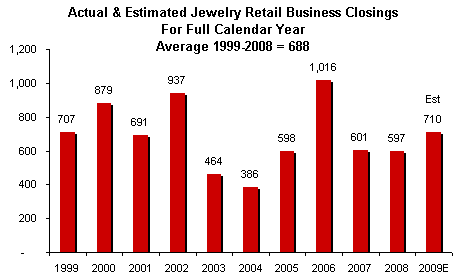
Source: BLS